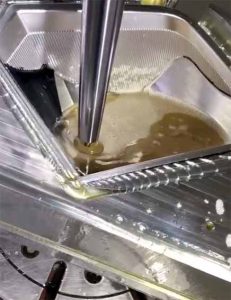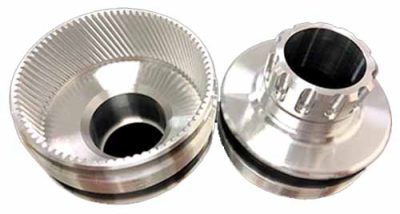Las piezas CNC inclinadas se encuentran a menudo en el proceso de producción.. Necesito golpear, aburrido, y fresado de formas en la superficie inclinada. O es necesario procesar varias superficies inclinadas con diferentes direcciones y diferentes pendientes en la misma sujeción., y cada superficie inclinada tiene un requisito de tolerancia geométrica más alto.
The numerical control system of the high-performance 5-axis milling machining center has the function of rotating the space coordinate system and the compensation function of the inclined machining tool. This makes it possible to process some parts that require bevel CNC machining and have relatively high machining accuracy. Al mecanizar en un plano inclinado, Es difícil compilar un programa de mecanizado porque el sistema de coordenadas cambia en el espacio.. Need to break through the conventional programming thinking mode for programming, and special processing of the program. This article discusses this issue in conjunction with the actual machining of inclined CNC products.

Fresado CNC de piezas inclinadas.
The conventional method of processing such inclined parts is to pull the machine head, rotate the work surface or use a modular fixture. If the processing direction or processing position is different, a second clamping and re-alignment are required, and the processing process is extremely cumbersome. Due to the limitation of the clamping positioning and the machine tool itself, the machining accuracy of the parts cannot be guaranteed. There are many holes on the inclined surface parts, and the special-shaped surface is not easy to clamp, and the positioning datum is not good. Multiple clamping causes accumulation of errors, and sometimes the margin error of the hole exceeds 1mm.
In order to solve the processing problems of this kind of parts, through continuous exploration and continuous improvement of process methods. Combined with the existing machine tools in the factory, a 5-axis CNC milling machining center was selected to solve this problem. The selected machine tool is 5-axis linkage, in addition to 3 linear axes, it also has two rotary axes (C axis: -360°~360°) and swing head (B axis: 0°~110°) . The control system is FANUC160i, which has the function of rotating the space coordinate system and the compensation function of the inclined surface machining tool.
From the perspective of realizing the processing of beveled parts, after one clamping, multiple processing needs such as boring, tocando, and milling of multiple bevels in different directions and different angles can be completed. It reduces the number of clamping times, reduces labor intensity, shortens the production cycle of products, and more importantly, improves the processing accuracy of parts and ensures the consistency of product quality.

Bevel thread of 5-axis machined parts
The parts are shown in the figure below:
To machine this window, it can be seen that the machine tool should complete a 2-axis linkage interpolation on the XZ and YZ planes and a spindle head swing motion. Because to make the tool perpendicular to the machined surface, the spindle must complete a head swing movement. The spindle has a swing head, which involves a series of multi-axis machining issues such as swing length. Por lo tanto, it is necessary to use multi-axis programming methods to complete, programming and machine tool debugging are difficult, which puts forward higher requirements for programmers and machine tool operators. In practical applications, taking into account factors such as ensuring the safety of the machine tool, it is necessary to simulate the machining process and perform multiple air cuts to ensure that the program is correct before formal machining can be carried out. Además, the multi-axis program algorithm is quite complicated, and the influence of factors such as pendulum length needs to be considered. There must be a specific post-processing for a certain machine tool, but the post-processing is often due to the influence of the algorithm and the control position, as well as the stability of the calculation. The program obtained through software post-processing is often difficult to meet the requirements of the accuracy of part drawings in terms of control accuracy.
The direct cause of the increase in programming difficulty is the appearance of inclined planes. Por lo tanto, if the machining plane can be made to coincide with the inclined plane, then this kind of problem will be transformed into a two-axis semi-processing programming problem, and the programming difficulty will be greatly reduced. Por lo tanto, first use the coordinate system conversion function of the machine tool (G68 command) to make the machining plane coincide with the inclined plane. Segundo, use the tool length compensation command (G432) to add the tool length in the vertical direction of the inclined plane. After the above processing, the problem of bevel processing is transformed into plane processing to solve, so that the programming difficulty is greatly reduced. If you need to process multiple inclined planes at the same time, you only need to rotate the C axis to C0 (the zero position of the worktable, the direction of the zero position is the same as the swing direction of the spindle), and then realize the processing by rotating the coordinate system and increasing the tool length. If the processing shape is relatively simple, the programming work can be completed manually. This makes it possible to realize machining on multiple inclined surfaces, multiple workstations, and multiple tool changes in a single clamping of the CNC machine tool.
 English
English العربية
العربية 中文(漢字)
中文(漢字) Čeština
Čeština Dansk
Dansk Nederlands
Nederlands Suomi
Suomi Français
Français Deutsch
Deutsch Italiano
Italiano 日本語
日本語 ಕನ್ನಡ
ಕನ್ನಡ 한국어
한국어 Português
Português Русский
Русский Slovenčina
Slovenčina Español
Español Svenska
Svenska Türkçe
Türkçe

